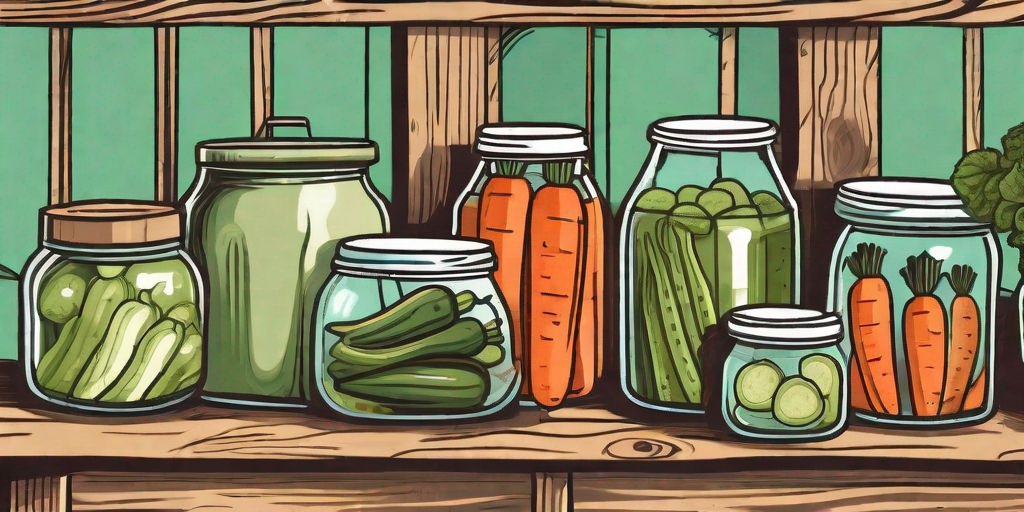
Welcome, dear reader, to the world of pickling, fermenting, and canning, where vegetables don't just survive, they thrive! This is a place where cucumbers become pickles, cabbage becomes sauerkraut, and tomatoes become... well, canned tomatoes. But hey, they're still delicious! So, strap on your apron, grab your favorite veggie, and let's dive into the wonderful world of preserving.
The Basics of Preserving
Before we get our hands dirty, let's understand the basics. Preserving is an age-old technique used to extend the life of food. It's like giving your vegetables a superpower - the ability to stay fresh and tasty for a long, long time. The three main methods of preserving vegetables are pickling, fermenting, and canning.
Now, you might be thinking, "Aren't they all the same?" Well, dear reader, they might seem similar, but each method has its own unique process and results in a distinct flavor profile. So, let's break it down.
Pickling
Pickling is like a spa treatment for your vegetables. They get to soak in a bath of vinegar, water, and some salt. The vinegar's acidity creates an environment where bacteria can't survive, thus preserving the vegetables. The result? Crunchy, tangy delights that can jazz up any meal.
And no, pickling isn't just for cucumbers. You can pickle almost any vegetable - carrots, onions, beets, you name it. If it's a vegetable, it can probably be pickled.
Fermenting
Fermenting is a bit more science-y. It involves the transformation of sugars to acids, gases, or alcohol using yeast or bacteria. In the case of vegetables, we're talking about lactic acid fermentation. This process not only preserves the vegetables but also enhances their nutritional value. Plus, it gives them a unique, tangy flavor.
Common fermented foods include sauerkraut (fermented cabbage) and kimchi (a spicy, fermented Korean side dish made from cabbage and other veggies). But again, don't limit yourself. The world of fermenting is your oyster... or your carrot, or your beet, or your...
Canning
Last but not least, we have canning. This method involves placing vegetables in a can or a jar and heating them to kill any microorganisms. The heating process also expels air from the jar, creating a vacuum seal that prevents new bacteria from entering and spoiling the food.
Canning is a great way to preserve a variety of vegetables in their natural state or in sauces or brines. It's like capturing the essence of summer in a jar, ready to be enjoyed in the depths of winter.
How to Preserve Your Vegetables
Now that you're familiar with the basics, let's get to the fun part - the actual preserving. Don't worry, it's not as daunting as it might seem. In fact, it's quite simple once you get the hang of it.
How to Pickle
First, choose your vegetable. Then, prepare a pickling solution of vinegar, water, and salt. You can also add sugar, spices, or herbs for extra flavor. Once your solution is ready, place your vegetables in a jar, pour the solution over them, and seal the jar. Then, simply wait for the magic to happen. After a few days, your pickles will be ready to enjoy.
How to Ferment
Fermenting involves a bit more patience. First, chop your vegetables and mix them with salt. The salt draws out the water from the vegetables, creating a brine where the fermentation process will take place. Place the mixture in a jar, making sure the vegetables are fully submerged in the brine. Then, cover the jar and let it sit at room temperature. After a week or two, your fermented veggies will be ready to devour.
How to Can
Canning requires some special equipment, like a canning jar and a pressure canner or a boiling water canner. Once you have your equipment, prepare your vegetables and place them in the jar. Then, follow the specific canning process for your chosen vegetable. This usually involves heating the jars to kill any bacteria and create a vacuum seal.
FAQs
Can I use any type of vinegar for pickling?
While you can technically use any type of vinegar for pickling, white vinegar is usually the best choice due to its neutral flavor. However, feel free to experiment with different types of vinegar to find your preferred flavor profile.
Can I ferment any type of vegetable?
Most vegetables can be fermented, but some are better suited for the process than others. Cabbage, cucumbers, and carrots are popular choices, but feel free to experiment with other vegetables as well.
Do I need to sterilize my jars before canning?
Yes, sterilizing your jars before canning is crucial to kill any bacteria that might spoil your food. You can sterilize your jars by boiling them in water for 10 minutes.
Conclusion
And there you have it, the art of preserving vegetables. It's a fun, rewarding process that allows you to enjoy your favorite veggies all year round. Plus, it's a great way to reduce food waste and make the most of your garden's bounty. So, why not give it a try? Your taste buds (and your wallet) will thank you.
Remember, preserving is not just a method, it's a lifestyle. It's about embracing the old ways, getting creative in the kitchen, and savoring the fruits (or in this case, vegetables) of your labor. So, get pickling, fermenting, and canning, and let the veggie adventures begin!











